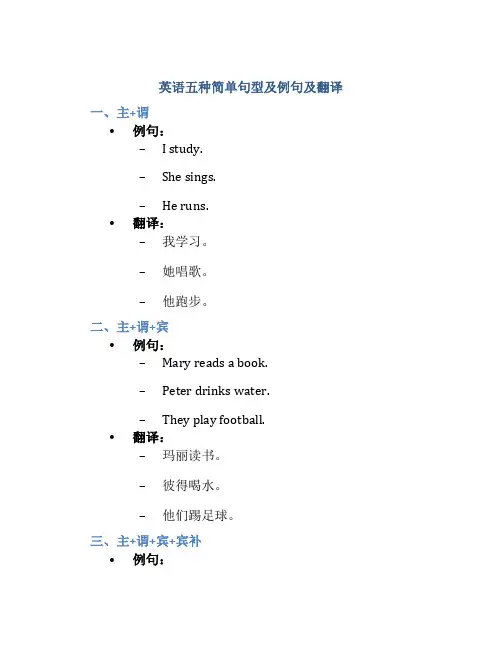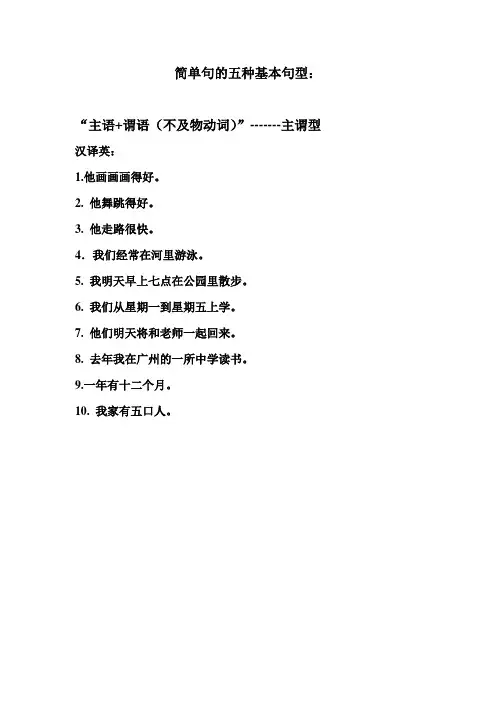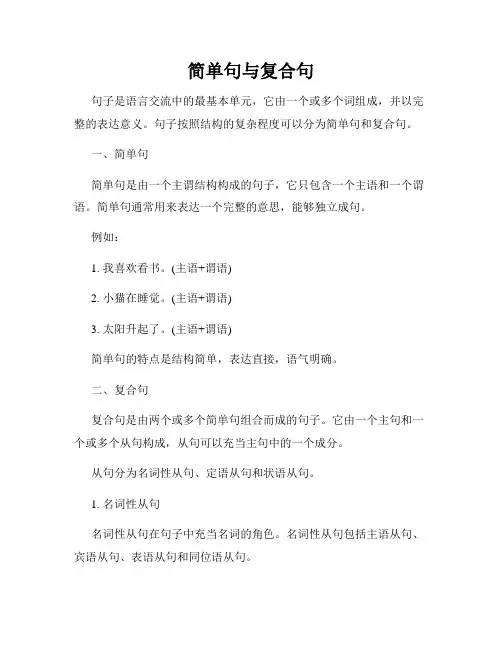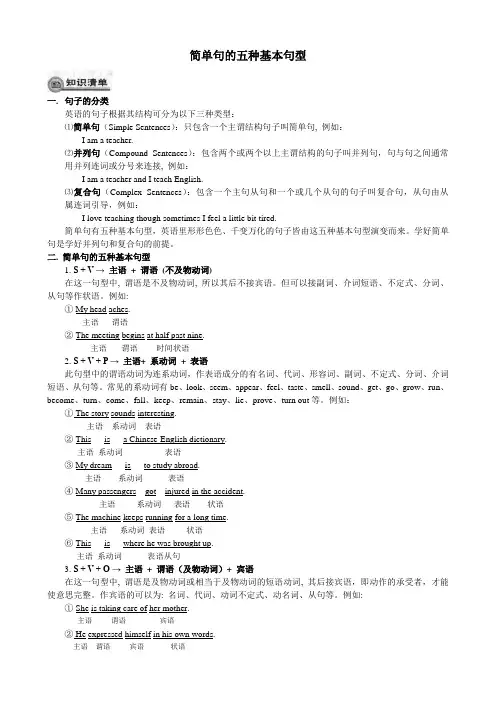简单句
- 格式:docx
- 大小:15.71 KB
- 文档页数:4

英语五种简单句型及例句及翻译
一、主+谓
•例句:
–I study.
–She sings.
–He runs.
•翻译:
–我学习。
–她唱歌。
–他跑步。
二、主+谓+宾
•例句:
–Mary reads a book.
–Peter drinks water.
–They play football.
•翻译:
–玛丽读书。
–彼得喝水。
–他们踢足球。
三、主+谓+宾+宾补
•例句:
–She painted the wall red.
–They elected John president.
–He considers the idea impossible.
•翻译:
–她把墙刷成了红色。
–他们选举约翰为总统。
–他认为这个想法是不可能的。
四、主+系+表
•例句:
–She is a doctor.
–He was happy.
–They will be late.
•翻译:
–她是一名医生。
–他很高兴。
–他们会迟到。
五、主+谓+间宾+直宾
•例句:
–John gives Mary a present.
–She told me a story.
–They show us the way.
•翻译:
–约翰给了玛丽一个礼物。
–她告诉了我一个故事。
–他们向我们指出了方向。
希望以上简单句型及例句的分析能够帮助您更好地理解英语语法。
让我们一起努力学习,提高英语水平!。

英语句子结构分类英语句子结构分类:简单句,并列句和复合句的概念及区别1.简单句:无论句子长短,只包含一套主谓结构,句子中个个成分都是单词或短语。
有时主语或谓语可以是并列结构。
请划出下面句子的主谓宾成分。
The accident happened yesterday afternoonOur English teacher is thirty years old.He put the dictionary in the backpack.Grandma told me an interesting story last night.She kept the door open.My classmates and friends all received my Christmas cards and thanked me very much.2.并列句: 由并列连词and/but/or/so/however/for等把两个或两个以上的简单句连接起来。
如:Come here and I’ll help you. 请划出两个分句并判断各分句的成分。
并列连词:一、表转折的并列连词主要有but(但是), yet(可是), while(而,却)等二、表选择的并列连词主要or (或者,还是,否则), either, or (不是、就是), neither, or,(既不、也不) otherwise (要不然)等。
三、表联合的并列连词主要有and, not only, but also,(不但,而且), when(=and just at this time 就在这时)等。
四、表因果的并列连词主要有for(因为), so(因此)等。
并列句例句:1. This is the custom of China. They are not like us to finish it in one drink, _____but_____prefer to drink by taking a small amount at a time.2. My mother wants to decorate our rooms in a modem look__while_____my father prefers a traditional style.3. It was time for her to have a new baby, ___and____it was also time for the young panda to independent.4. He is a shy man,__but/yet_______he is not afraid of anything or anyone. 解析:But/yet转折连词。

简单句的五种基本句型:“主语+谓语(不及物动词)”-------主谓型汉译英:1.他画画画得好。
2. 他舞跳得好。
3. 他走路很快。
4.我们经常在河里游泳。
5. 我明天早上七点在公园里散步。
6. 我们从星期一到星期五上学。
7. 他们明天将和老师一起回来。
8. 去年我在广州的一所中学读书。
9.一年有十二个月。
10. 我家有五口人。
“主语+谓语(及物动词)+宾语”-------主谓宾型汉译英:1.我们很喜欢足球。
2.孩子们非常喜欢他们的老师。
3.上星期六我在书店看见他们了。
4.昨天我很仔细地看了这个人。
5.我有100本故事书。
6.我们晚上七点半吃晚饭。
7.我的箱子里有100本故事书。
8.我们每天晚上在家做作业。
9.我们每天上七节课。
10.刚才他打电话给我。
“主语+连系动词+表语”-------主系表型汉译英:1.去年他16岁,今年他17岁。
2.他在二年级一班。
3.你爸爸在上海。
4.你很帅。
5.这孩子很聪明。
6.这故事很有趣。
改错:1.She very tall.2.The problem easy.3.The shoes on the floor.4.The old man 90 years old.5.I am play table tennis every Saturday.6.We are go to school at 6:00 in the morning.7.He was got up early this morning.“主语+谓语(及物动词)+间接宾语+直接宾语”-------主谓宾宾型汉译英:1.我的朋友每个月给我写一封信。
2.我将把我的自行车借给他。
3.上星期六妈妈给我做了一条新T恤衫。
4.我将给你带来一些新书。
5.上个星期我叔叔给我买了一辆自行车。
仿照示范改写句子。
并翻译成中文。
He gave her a notebook. (to)--- He gave a notebook to her .1.She lent the boy her eraser.(to)—2.Can you pass me the paper?(to)----3.My aunt often buys me presents.(for)---4.Who will fetch me some chalk?(for)----5.He played us a piece of music.(for)----“主语+谓语(及物动词)+宾语+宾语补足语”-------主谓宾补型汉译英:1.他们让我当这个队的队长。

简单句与复合句的区别简单句和复合句是语言中常见的两种句子结构。
它们在句子成分和结构上有所不同,本文将详细介绍简单句和复合句的区别。
一、简单句的特点简单句由一个主语和一个谓语构成,通常表达一个完整的含义。
以下是简单句的特点:1. 结构简单明了: 简单句通常只有一个主谓成分,不含任何修饰语或从句。
例如:- 我爱你。
主谓结构明确。
- 小狗跑了。
主谓结构简单。
2. 表达简洁直接: 简单句用较少的词汇表达直接的信息,简洁明了。
例如:- 太阳照耀大地。
简单、直接地表达了太阳照耀大地的事实。
3. 独立存在: 简单句可以单独成句,具有独立的语法性质。
例如:- 我很高兴。
这句话可以独立存在,表达了作者的情感。
二、复合句的特点复合句由一个或多个主句和一个或多个从句构成,从句在句子中充当各种成分。
以下是复合句的特点:1. 多个分句构成: 复合句由一个或多个主句和一个或多个从句构成,从句在句子中起到修饰、补充、解释等作用。
例如:- 我喜欢读书,因为它可以丰富我的知识。
句中包含两个分句,主句为“我喜欢读书”,从句为“因为它可以丰富我的知识”。
2. 句子关系复杂: 复合句中的主句和从句之间存在附属关系,从句对主句进行补充或说明。
例如:- 她哭了,因为她没考上大学。
主句“她哭了”和从句“因为她没考上大学”之间存在因果关系。
3. 句子结构灵活: 复合句的句子结构多样,可以根据需要灵活运用。
例如:- 即使天气很冷,他仍然去跑步。
主句为“他仍然去跑步”,从句为“即使天气很冷”。
三、简单句与复合句的区别简单句和复合句主要在结构、信息表达和句子关系上有所不同。
1. 结构差异: 简单句结构简单,由一个主谓成分构成;而复合句由一个或多个主句和一个或多个从句构成。
2. 信息表达差异: 简单句直接表达一个完整的含义,信息传递较为直接;而复合句通过从句对主句进行修饰、补充或解释,信息传递更加复杂、详细。
3. 句子关系差异: 简单句独立存在,不依赖其他句子;而复合句中的主句和从句之间存在附属关系,从句对主句进行补充或说明。

简单句例句
1. 我喜欢你呀!就像老鼠爱大米。
例子:他见到她就说:“我喜欢你呀!”,她红着脸笑了。
2. 这东西可真贵啊!简直就是在抢钱嘛。
例子:“哇,这个价格,这东西可真贵啊!”他忍不住抱怨道。
3. 你怎么这么笨呐!连这个都不会。
例子:她着急地说:“你怎么这么笨呐!”然后亲自示范。
4. 那家伙太坏了!跟狐狸一样狡猾。
例子:大家都议论:“那家伙太坏了!”
5. 今天的天气真好哇!适合出去玩耍。
例子:他高兴地喊:“今天的天气真好哇!”然后拉着朋友出门了。
6. 她笑得真甜呀!像朵盛开的花儿。
例子:看着她的笑容,有人说:“她笑得真甜呀!”
7. 这顿饭太好吃啦!我都要吃撑了。
例子:他摸着肚子说:“这顿饭太好吃啦!”
8. 他跑得可真快呀!像一阵风似的。
例子:观众们惊叹:“他跑得可真快呀!”
9. 这地方真美啊!仿佛人间仙境。
例子:游客们纷纷赞叹:“这地方真美啊!”
10. 你太棒啦!就没有你做不到的事。
例子:朋友对他竖起大拇指说:“你太棒啦!”
我的观点结论:这些简单句生动有趣,能很好地表达各种情绪和意思,在生活中很常用也很实用。

简单句与复合句句子是语言交流中的最基本单元,它由一个或多个词组成,并以完整的表达意义。
句子按照结构的复杂程度可以分为简单句和复合句。
一、简单句简单句是由一个主谓结构构成的句子,它只包含一个主语和一个谓语。
简单句通常用来表达一个完整的意思,能够独立成句。
例如:1. 我喜欢看书。
(主语+谓语)2. 小猫在睡觉。
(主语+谓语)3. 太阳升起了。
(主语+谓语)简单句的特点是结构简单,表达直接,语气明确。
二、复合句复合句是由两个或多个简单句组合而成的句子。
它由一个主句和一个或多个从句构成,从句可以充当主句中的一个成分。
从句分为名词性从句、定语从句和状语从句。
1. 名词性从句名词性从句在句子中充当名词的角色。
名词性从句包括主语从句、宾语从句、表语从句和同位语从句。
例如:1. 他说他会来。
(主语从句)2. 我不知道他在哪里。
(宾语从句)3. 你的问题是什么?(表语从句)4. 我听说他是一位科学家。
(同位语从句)名词性从句的特点是构造复杂,可以替代名词在句子中担任成分。
2. 定语从句定语从句用于修饰名词或代词,说明该名词或代词的特征、性质或身份。
例如:1. 我喜欢的那本书很有趣。
(修饰书的定语从句)2. 那个穿红衣服的女孩是我的妹妹。
(修饰女孩的定语从句)定语从句的特点是在句子中作为定语修饰名词或代词,增加了句子的丰富性和表达能力。
3. 状语从句状语从句用于表示条件、原因、目的、结果等与主句之间的关系。
例如:1. 如果明天下雨,我们就不去郊游了。
(条件状语从句)2. 因为天气太冷,他决定去买一件厚外套。
(原因状语从句)3. 为了学好英语,他每天早起一个小时。
(目的状语从句)4. 她累坏了,以致于晚上没办法去参加聚会。
(结果状语从句)状语从句的特点是在句子中起到修饰主句或交代主句情况的作用,增加了句子的信息量。
总结:简单句和复合句是语言表达中常见的两种句子结构。
简单句由一个主谓结构构成,表达直接、简洁;复合句由一个主句和一个或多个从句构成,句子结构复杂,表达丰富。

英语简单句的五种基本句型只包含一个主语(或并列主语)和一个谓语(或并列谓语)的句子,称作简单句。
简单句有以下5种基本句型。
1、S主+Vi不及物:Wecome我们来;2、S主+V系+P表:Classisover下课了;3、S主+Vt及物+O宾:Shehateshim她恨他;4、S主+Vt及物+IO间宾+DO直宾:Shegavemeanewbook.他给了我一本新书;5、S主+Vt及物+O宾+OC宾补:WenamedourbabyTom.我们给孩子取名汤姆。
5种基本句型用法详解1、主+谓=S+Vi(主+不及物动词)主语:可以作主语的成分有名词,主格代词,动词不定式,动名词等等。
主语一般在句首。
谓语:谓语由动词构成,是英语时态、语态变化的主角,一般在主语之后。
不及物动词(vi.)没有宾语,形成主谓结构,如:S(主)+Vi(不及物动词)(谓语)Thebabycried.婴儿哭了Wecome.我们来1)S+Vi+副词(状语)eg:Birdssingbeautifully.2)S+Vi+介词短语(状语)eg:Hewentonholiday.3)S+Vi+不定式(状语)eg:Westoppedtohavearest.4)S+Vi+分词(状语)eg:I'llgoswimming.此句型的句子有一个共同特点:即句子的谓语动词都能表达完整的意思。
这类动词叫做不及物动词,后面可以跟副词、介词短语、状语从句等。
2、S+V系+P(主+系+表)此句型的句子有一个共同的特点:句子谓语动词都不能表达一个完整的意思,必须加上一个表明主语身份或状态的表语构成复合谓语,才能表达完整的意思。
这类动词叫做连系动词。
表语也就是主语的补足语ThisisanEnglish-Chinesedictionary.Thedinnersmellsgood.Heisgrowingtallandstrong.1)S+V+名词/代词eg:Heisaboy.2)S+V+形容词eg:Sheisbeautiful.3)S+V+副词eg:Classisover.4)S+V+介词短语eg:Heisingoodhealth.5)S+V+分词eg:Heisexcited.3、S+Vt+O(主+及物+宾)此句型句子的共同特点是:谓语动词都具有实义,都是主语产生的动作,但不能表达完整的意思,必须跟有一个宾语,动作的承受者,才能使意思完整。

简单句的基本句型
1. 我喜欢在周末去公园散步,感受大自然的美好。
2. 她每天早上都喜欢喝一杯热茶,开始新的一天。
3. 在家里放一盆绿植,可以净化空气,增添生活情趣。
4. 学习一种新的乐器,可以激发大脑的活力,提升自己的音乐能力。
5. 阅读是一种很好的习惯,可以开阔视野,丰富知识。
6. 生活中遇到困难时,不要轻易放弃,要坚持努力,相信自己一定能克服。
7. 朋友是人生中很重要的一部分,可以分享快乐,共同度过困难。
8. 每天保持一定的运动量,可以增强体质,提高免疫力。
9. 做一顿美味的晚餐,可以放松心情,享受美食带来的快乐。
10. 旅行是一种很好的放松方式,可以体验不同的文化,结交新朋友。

1.你好: 啊你啊塞哟2.多多关照: 擦儿不大卡米大3.谢谢: 卡目沙米大4.对不起: 罪送哈米大5.见到你很高兴: 满拉索盼嘎不是米大6.再见,走好(主任对客人说的话): 安宁习, 卡色哟7.再见,走好(客人对主任说的话): 安宁习, 给色哟8.我爱你: 萨郎黑哟9.喜欢: 做啊黑哟10.吃好啊: 吗习给多色哟11.我吃饱了: 别不儿罗哟12.肚子饿了: 过怕哟13:我联系你: 眼儿拉卡儿给哟14.晚安: 安宁习, 租目塞哟15.生日快乐: 生一儿, 粗卡哈米大16.加油: 啊杂,啊杂,华一艇(A ZA A ZA FIGHTING)17.哥哥, 我喜欢你: 哦爸, 萨郎黑哟18.请帮我: 多哇住塞哟19.我叫...: 错能...20.我是中国人: 错能, 总谷沙拉米米打词语:1.知道: 啊拉嗦2.开始: 洗嫁3.勇气: 庸 gi(第三个声)4.王的男人: 枉gie腩人5.真是的: 啊西6.你先说: on这巴爹哟7.他们: kei du(第三声)8.没有(不是): 啊你哦9.你是谁?: 怕你衣死尬?10.你疯了: u捉索11.但是: 肯爹12.奇怪: 衣索念13.什么: 爹?14.是: 爹家庭:1.父亲: 啊波几2.母亲: 啊莫你3.祖父: 哈拉波几4.祖母: 哈日莫你5.叔叔: 身ten(第三声)6.阿姨: E莫7.女儿: 呆儿8.儿子: 啊得儿9.哥哥: 轰您(第三声)10.弟弟: 男东先11.姐姐: on你12.妹妹: 哟东先13.侄子: 左(第一声)卡14.妻儿: 不(第一声)印15.丈夫: 男骗儿16.孙子: 孙杂17.孙女: 孙女哟18.岳父: 汤引19岳母: 汤莫20.婴儿: 哟啊21.男士: 男杂22.女士: 哟杂23.朋友: 亲古24.同事: 东木25.搭档: 滩杂26.邻居: 衣屋27.孩子: 啊义28.青年: 称你恩29.成年: 孙你恩30.夫人: 不(第一声)印31.新郎: 新囊(第四声)32.新娘: 新补职业:1.演员: gie屋2.医生: A刹3.翻译: bwn 诺嘎4.警察: gon差儿5.老师: 称签您(第三声)6.讲师: 刚刹7.律师: gon诺刹8.记者: gi杂9.教授: 高属10.校长: 郭丈11.工程师: an军你儿12.农夫: 农(第一声)补13.画家: 花尬14.政治家: 睁西尬15.店员: 种稳16.经理: 江里17.理发师: E把刹18.音乐家: 饿妈尬19.公务员: 公木稳20.作家: 杂尬21.秘书: 逼索(第四声)22.外交家: 岳郭gun(第三声)23.舞蹈家: 木拥尬24.检查官: 工擦关25.部长: 不(第一声)丈26.董事长: E刹丈27.董事: E刹28.业务员: 喔木稳29.公司职员: 挥杀稳30.工人: 诺(第一声)东杂31.社长: 擦丈32.家庭主妇: 尬种主补交通建筑物:1.人行道: 机多2.街道: 郭力3.方向: 帮hian儿4.路线: 挪(第一声)孙(第三声)5.火车: 低踏6.公共汽车: 波死7.卡车: 特落8.货车:特落9轿车: 杂东擦10.地铁: 机哈撤11.停车场: 朱擦丈12.高架: 郭尬13.加油站: 朱沟索14.轻轨: 机哈撤15.终点站: 通敏呢16.高速公路: 郭索多落。

简单句的五种基本句型一. 句子的分类英语的句子根据其结构可分为以下三种类型:⑴简单句(Simple Sentences):只包含一个主谓结构句子叫简单句, 例如:I am a teacher.⑵并列句(Compound Sentences):包含两个或两个以上主谓结构的句子叫并列句,句与句之间通常用并列连词或分号来连接, 例如:I am a teacher and I teach English.⑶复合句(Complex Sentences):包含一个主句从句和一个或几个从句的句子叫复合句,从句由从属连词引导,例如:I love teaching though sometimes I feel a little bit tired.简单句有五种基本句型,英语里形形色色、千变万化的句子皆由这五种基本句型演变而来。
学好简单句是学好并列句和复合句的前提。
二. 简单句的五种基本句型1. S + V →主语+ 谓语(不及物动词)在这一句型中, 谓语是不及物动词, 所以其后不接宾语。
但可以接副词、介词短语、不定式、分词、从句等作状语。
例如:①My headaches.主语谓语②The meetingbeginsat half past nine.主语谓语时间状语2.S + V + P → 主语+ 系动词+ 表语此句型中的谓语动词为连系动词,作表语成分的有名词、代词、形容词、副词、不定式、分词、介词短语、从句等。
常见的系动词有be、look、seem、appear、feel、taste、smell、sound、get、go、grow、run、become、turn、come、fall、keep、remain、stay、lie、prove、turn out等。
例如:① The storysoundsinteresting.主语系动词表语②Thisisa Chinese-English dictionary.主语系动词表语③My dreamisto study abroad.主语系动词表语④Many passengersgotinjuredin the accident.主语系动词表语状语⑤The machinekeepsrunningfor a long time.主语系动词表语状语⑥Thisiswhere he was brought up.主语系动词表语从句3.S + V + O →主语+ 谓语(及物动词)+ 宾语在这一句型中, 谓语是及物动词或相当于及物动词的短语动词, 其后接宾语,即动作的承受者,才能使意思完整。

简单句和复合句一、简单句简单句就是我们之前学的由五个基本句型构成的句子,包括它们的肯定句,疑问句和否定句。
之前的课程把五个基本句型简化为两个:一个是动作的句型(主语+谓语+宾语),一个是状态的句型(主语+系动词+表语)。
当然,也包括there be句型以及被动句。
其实,我们可以这样理解简单句:由词语或者短语构成各个句子成分的句子。
我们学过的词语常用的有:名词,代词,形容词,动词,介词,副词等等。
常用的短语有:介词短语,动名词短语,动词不定式短语,过去分词短语。
如果一句话,句子成分都由以上的词语或短语构成,那么这个句子就称为简单句。
请看下面的例子:I like English.(我喜欢英语)主语谓语宾语这句话的主语,谓语和宾语都是由词语构成的,代词“I”作主语,动词“like”作谓语,名词“English”作宾语。
I like learning English.(我喜欢学英语)主语谓语宾语这句话的主语,谓语都是由词语构成的,而宾语是由动名词短语“learning English”充当的。
类似于这两句话的句子,都称为简单句。
注意,简单句不一定是简单的,也不一定是很短的。
简单句最重要的要求是由单词和短语构成句子成分。
有时候,英语的短语并不短。
这个之前就特别强调过,所以下面这么长的句子,也属于简单句,因为构成句子成分的都属于单词或短语。
1.A beautiful young tall girl wants to marry a very handsome rich man from Beijing.2.My plan is to buy a beautiful house with a garden and a swimming pool.如果对简单句还不理解,也可以通过下面的表格内容去理解。
了解简单句,就是为了更好地理解下面的复合句。
二、复合句复合句又称主从复合句,由一个主句和一个或一个以上的从句构成,主句为句子的主体,从句不能独立,只用作句子的一个成分,如主语、表语、宾语、介词宾语、定语、同位语、状语(包括地点、条件、时间、原因、让步、比较、结果等状语)。
简单句和复合句的区别简单句和复合句是语法中的两个基本概念,简单句包括一个主语和一个谓语,表达一个完整的意思。
而复合句则是包括一个或多个子句的句子,子句可以是简单句或其他类型的句子。
下面我们将更详细地解释这两个概念的区别。
1. 简单句简单句通常由一个主语和一个谓语组成。
主语是句子的话题,通常表示人或事物;谓语是句子的行为或状态,描述主语的动作、状态、性质等。
例如:- 我们走了。
这是一个简单句,主语是“我们”,谓语是“走了”,表示我们离开了某个地方。
- 饭菜很好吃。
这是一个简单句,主语是“饭菜”,谓语是“很好吃”,表示食物非常美味。
简单句是语法中最基本的句子类型,它们表达一个单一的思想。
不过,简单句可以通过添加修饰语等形式变得更加复杂,例如:- 我们在公园里看到了一只漂亮的蝴蝶。
- 他住在一所大房子里,每天开着豪车上班。
这些句子中添加了修饰语,但前提仍然是一个主语和一个谓语,它们构成了完整的思想。
2. 复合句复合句包括一个或多个子句,指定多个事件或概念,并且它们之间存在某种关系,例如因果、条件或时间上的联系。
每个子句都可以包括一个主语和一个谓语,但是,一个主语和谓语的子句本身不能构成完整的句子,它们需要根据语境和思维语境与其他子句组合使用。
例如:- 我们想要旅游,但天气糟透了。
- 因为他生病了,所以他没有去上班。
在这些句子中,第一个例子包括两个子句,“我们想要旅游”和“天气糟透了”,它们之间使用了连词“但”。
在第二个例子中,第一个子句“因为他生病了”说明了第二个子句“他没有去上班”的原因,两个子句之间使用了连词“所以”。
复合句通常比简单句更复杂,因为它们包括多个主题和行动,并且使用了复杂的结构来表达各种意思。
例如,“我去学校,顺便买些东西”在语法上合法,但是因为它在意义上不连贯,因此并不是复合句。
复合句可以通过不同的连接词、独立主句等进行不同的变化,以满足人们表达不同的语境和思维需要。
综上所述,简单句包括单一的主题和行动,而复合句则由多个主题和行动组成。
英语六大简单句的定义、特点和例子英语中,句子的结构可以分为简单句、并列句、复合句和复杂句。
简单句是由一个主语和一个谓语组成的最基本的句子类型,没有从句或并列成分。
简单句可以根据谓语的不同,分为六种类型:主谓结构、主系表结构、主谓宾结构、主谓双宾结构、主谓宾补结构和主谓状结构。
本文将介绍这六种简单句的定义、特点和例子,帮助读者掌握英语简单句的用法和变化。
一、主谓结构主谓结构是最简单的一种简单句,由一个主语和一个不及物动词组成,表示一个动作或状态。
不及物动词是指不能带宾语的动词,如run, sleep, cry等。
主谓结构的基本形式是:主语 + 不及物动词例如:He runs every morning. 他每天早上跑步。
She sleeps well. 她睡得很好。
The baby cried. 婴儿哭了。
主谓结构可以通过添加状语来修饰不及物动词,表示时间、地点、方式、原因等。
状语可以是副词、介词短语或从句等。
例如:He runs fast. 他跑得快。
She sleeps in her room. 她在她的房间睡觉。
The baby cried because he was hungry. 婴儿因为饿了而哭。
二、主系表结构主系表结构是由一个主语、一个系动词和一个表语组成的简单句,表示一个判断或说明。
系动词是指用来连接主语和表语的动词,如be, become, seem等。
表语是指用来说明或补充主语的成分,可以是名词、形容词、副词、介词短语或从句等。
主系表结构的基本形式是:主语 + 系动词 + 表语例如:He is a teacher. 他是一名老师。
She became angry. 她变得生气了。
It seems interesting. 这看起来很有趣。
主系表结构可以通过添加状语来修饰系动词或表语,表示时间、地点、方式、原因等。
例如:He is a teacher in our school. 他是我们学校的一名老师。
简单句的五种基本句型1、主语+不及物动词(S+V)[例句]1.The man cooks.男人做饭。
2.The sun is shining brightly.太阳在明亮地照耀着。
3.We all breathe,eat,and drink.我们呼吸、吃和喝。
4.They talked for half an hour.他们谈了半个小时。
5.They were singing when we arrived.我们到的时候他们正在唱歌。
[分析]这些句子有一个共同的特点:谓语动词都能表达完整的意思,不需加宾语。
这类动词叫做不及物动词,后面可以跟副词、介词短语、状语从句等。
二、主语+及物动词+宾语(S+V+DO)[例句]1.Who knows the answer?谁知道答案?2.He enjoys reading.他喜欢看书。
3.They ate what was left over.他们吃了剩饭。
4.He said“Good morning.”他说:“早上好!”5.I want to have a cup of tea.我想喝杯茶。
[分析]这些句子的共同特点是:谓语动词都具有实义,都是主语产生的动作,但不能表达完整的意思,必须跟有一个宾语,即动作的承受者,才能使意思完整。
这类动词叫做及物动词。
三、主语+系动词+表语(S+V+P)[例句]1.This is an English-Chinese dictionary.这是本英汉辞典。
2.The cake smells good.蛋糕味道很好。
3.Everything looks different.一切看来都不同了。
4.He is growing tall and strong.他长得又高又壮。
5.The trouble is that they are short of money.麻烦的是他们缺少钱。
6.Our well has gone dry.我们的井干枯了。
陈述句,疑问句,祈使句,感叹句主动句被动句副词的位置英语句子纷繁复杂,多种多样,但是按照其结构组成的不同,可以划分为三种类型简单句:只有一个主语(或并列主语)和一个谓语(或并列谓语)的句子叫做简单句。
并列句复合句(同位语从句与定语从句的区别)简单句又可分为五大基本句型,这五个基本句式如下S十V 主谓S十V十P 主系表S十V十O 主谓宾S十V十O1十O2 主谓双宾S十V十O十C 主谓宾宾补说明S主语V谓语P表语O宾语O1间接宾语O2直接宾语C宾语补足语简单句的五种基本句型1.主语+谓语S+V此句型的特点是:谓语动词是不及物动词,本身能表达完整的意思,后面不需跟宾语,但有时可跟副词、介词短语等作状语,这类动词叫做不及物动词。
如: He laughed.John has read widely.He lives in London.His words work.Birds fly.鸟会飞。
It happened in June 1932.这件事发生于一九三;年六月。
My watch stopped.我的表停了。
She spoke at the meeting yesterday evening. 她在昨天晚上的会上发了言。
2.主语+及物动词+宾语S+V+O此句型的特点是:谓语动词是及物动词, 是实意动词,但不能表达完整的意思,必须跟有一个宾语,及动作的承受者,才能使意思表达完整,这类动词叫做及物动词。
如: Our team beat all the others.We like the movie.She often helps her mother.He wants a cup of coffee.3.主语+系动词+表语 S+V+P此句型的特点是:谓语动词是连系动词,不能表达完整的意思,必须加上一个表明主语特征、身份、状态的表语。
常见的系动词有:be(是),become(成为),get(变得),turn(变得),grow(变得),look(看起来),feel(感到),smell(闻起来),taste(尝起来),sound(听起来),seem(似乎),keep(保持),stay(保持)等。
简单句的五种基本句型讲解及练习题
一、句子成份
英语句子成分有主语,谓语,宾语,宾语补足语,表语,定语,状语等。
顺序一般是主语,谓语,宾语,宾语补足语,而表语,定语,状语的位置要根据情况而定。
1、主语:表示句子主要说明的人或事物,一般位于句首。
但在therebe 结构、疑问句(当主语不疑问词时)和倒装句中,主语位于谓语、助动词或情态动词后面。
主语可由名词、代词、数词、不定式、动名词、名词化的形容词和主语从句等表示。
例如:Countrymusichasbecomemoreandmorepopular.(名词)WeoftenspeakEnglishinclass.(代词)
One-thirdofthestudentsinthisclassaregirls.(数词)Toswimintheriverisagreatpleasure.(不定式)Smokingdoesharmtothehealth.(动名词)Therichshouldhelpthepoor.(名词化的形容词)WhenwearegoingtohaveanEnglishtesthasnotbeendecided.(主语从句)Itisnecessarytomasteraforeignlanguage.(it作形式主语,真正的主语为后面的不定式)
2、谓语:谓语说明主语的动作,状态或特征。
可以有不同的时态,语态和语气。
1)简单谓语:Westudyforthepeople.2)复合谓语:
IcanspeakalittleEnglish.Wearereadingbooks.HehasgonetoBeijing ..
3、表语:它位于系动词(比如be)之后,说明主语身份,特征,属性或状态。
Mysisterisanurse.
Isityours?(代词)
Theweatherhasturnedcold.(形容词)Thespeechisexciting.(分词)Threetimessevenistwentyone?(数词)HisjobistoteachEnglish.(不定式)
Hishobby(爱好)isplayingfootball.(动名词)Therulermustbeinyourbox.(介词短语)
Timeisup.Theclassisover.(副词)Thetruthisthathehasneverbeenabroad.(表语从句)
4、宾语:宾语表示动作行为的对象,跟在及物动词之后,WelikeEnglish.
Howmanydictionariesdoyouhave?Ihavefive.(数词)Theyhelpedtheoldwiththeirhouseworkyesterday.(名词化形容词)
Itbegantorain.(不定式短语)Ienjoylisteningtopopularmusic.(动名词短语)
Ithink(that)heisfitforhisoffice.(宾语从句)
有些及物动词可以带两个宾语,往往一个指人,一个指物,指人的叫间接宾语,指物的叫直接宾语。
Hegavemesomeink. 有些及物动词的宾语后面还需要有一个补足语,意思才完整,宾语和它的补足语构成复合宾语。
如:Wemakehimourmonitor(班长).
5、宾补:就是宾语补足语,就是补充说明宾语的Iseeyoucrossingthestreet HisfathernamedhimDongming.(名词)
Theypainted(涂漆)theirboatwhite.(形容词)
Letthefresh(新鲜的)airin.(副词)
Youmu stn’tforcehimtolendhismoneytoyou.(不定式短语)Wesawherenteringtheroom.(现在分词)Wefoundeverythinginthelabingoodorder.(介词短语)
6、定语:在句中修饰名词或代词的成分叫定语。
Heisanewstudent.但副词,动词不定式,介词短语等作定语时,则放在被修饰的词之后。
Thebikeintheroom/overthere/ismine. Guilinisabeautifulcity.(形容词)
Chinaisadeveloping(发展中)country;Americaisadeveloped(发达)country.(分词)Therearethirtywomenteachersisourschool.(名词)Hisprogress(进步)inEnglishmadeussurprised.(代词)Ourmonitor(班长)isalwaysthefirsttoentertheclassroom.(不
定式短语)
Heisreadinganarticle(文章)abouthowtolearnEnglish.(介词短语)7、状语:修饰动词,形容词,副词以及全句的句子成分,叫做状语。
状语一般放在被修饰的词之后或放在句尾。
副词作状语时可放在被修饰的词前或句首。
HelivesinLondon. Lighttravelsmostquickly.(副词及副词性词组)Hehaslivedinthecityfortenyears.(介...。